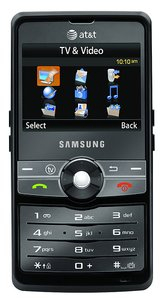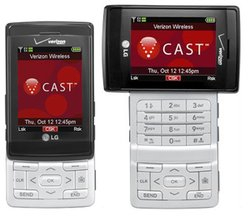 I asked the question in September, and I’ll ask it again: Do we really need live TV on our cell phones? AT&T, the largest U.S. carrier, says we do.
I asked the question in September, and I’ll ask it again: Do we really need live TV on our cell phones? AT&T, the largest U.S. carrier, says we do.
AT&T said Thursday it will offer live mobile TV service from MediaFLO in May through two handsets — the LG Vu and the Samsung Access. Subscribers willing to pony up the extra bucks (prices won’t be announced until later) will receive eight channels of live TV plus two exclusive channels in select markets.
AT&T offers everything from music to Web surfing is looking to live mobile TV as a way to earn additional revenue, something all the carriers desire as cell phone call prices continue to fall. Rival Verizon, the No. 2 U.S. carrier, already offers broadcast mobile TV through V-Cast.
Coincidentally, V-Cast has just turned a year old and is adding two additional channels, a bilingual MTV and ESPN Radio.
 Both Verizon and AT&T are in partnership with MediaFLO, a subsidiary of wireless chipmaker Qualcomm. MediaFLO uses analog broadcast TV spectrum it bought several years ago to deliver broadcast TV service to mobile devices. The network will operate in about 55 markets and will be available to about 200 million people by May.
Both Verizon and AT&T are in partnership with MediaFLO, a subsidiary of wireless chipmaker Qualcomm. MediaFLO uses analog broadcast TV spectrum it bought several years ago to deliver broadcast TV service to mobile devices. The network will operate in about 55 markets and will be available to about 200 million people by May.
Verizon hasn’t published specific numbers, but Qualcomm CEO Paul Jacobs — sounding a bit bitter — said during a speech at the Tech Policy Summit on Wednesday that the acceptance of live mobile TV is going slower than he would like, according to RCR Wireless (via CNET). He blames the carriers for not pushing the service hard enough.
“(The carriers) haven’t spent a lot of advertising on it to this point,” Jacobs said. “It’s not as nationwide as we would have liked.”
 Maybe, but I return to my original question: Do people want to watch broadcast TV on a mobile phone? Verizon charges $15 a month extra for V-Cast, which is considerable when people are already spending between $40 and $60 a month for services that can include Internet access and unlimited text messaging.
Maybe, but I return to my original question: Do people want to watch broadcast TV on a mobile phone? Verizon charges $15 a month extra for V-Cast, which is considerable when people are already spending between $40 and $60 a month for services that can include Internet access and unlimited text messaging.
The cell phone is rapidly evolving beyond simple communications devices, and what we are seeing here is the beginning of the specialized handset.
You want music? There are dozens of phones that already play music (and more are coming). Devices such as the iPhone are linked to stores like iTunes for over-the-air downloads. Nokia is hoping to lure the four major record labels with an approach it calls “Comes With Music.”
You want to play games? There’s the unproven-but-expected gaming side of the iPhone, or the as-of-yet-unseen PSP Phone from Sony. Who knows what kind of phones will evolve from Google’s mobile operating system Android. The cell phone-as-weapon for the Wi-Fi Army or a specialized Wii controller?
You want to create your own content? You got a bunch of picture-taking and video-recording phones from Nokia, Samsung, Sony Ericsson, and others that will continue to improve in quality. All that remains is in-phone content manipulation and ease of uploading and sharing.
And if you’re an AT&T subscriber interested in watching live TV, well, come May, you can have that, too.

Given my day job at Sling Media, I can tell you folks do want live (and recorded) television content on their mobiles. Of course, being carrier agnostic we offer a different proposition: Tune into the great content you’re already paying for utilizing any Internet connection. (Assuming a compatible handset, or computer.) Anyway, I’ll go easy on the sales pitch but I just had to chime in. 🙂
@ Dave Zatz
In the context of the SlingBox, live and recorded TV is a whole different ball game. Not least because it can be the best of all worlds – live, on-demand and at no added cost for going mobile (aside from the box itself).
The closest thing to a Sling experience that I have is the BBC’s iPlayer on my iPod touch (over WiFi). I’m addicted.